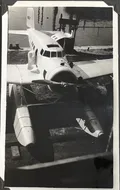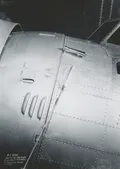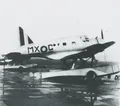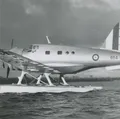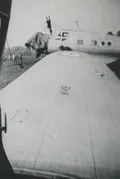Delta (Total: 20, Canadian: 20, Group 0)
Northrop Delta
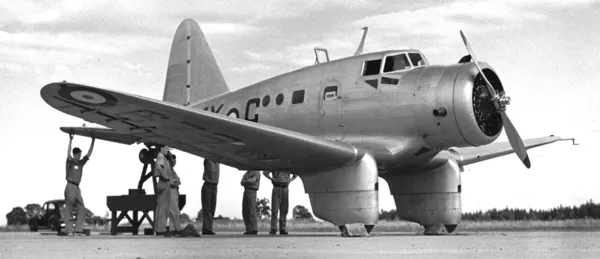
Canada selected the Delta for use as a photographic survey aircraft for use by the RCAF in 1935. They were built by Canadian Vickers Ltd under license. One aircraft, the last Delta built by Northrop, was supplied as a part assembled pattern to Canadian Vickers, first flying on 16 Aug 1936 and being delivered to the RCAF on 1 Sep that year. It was followed by a further 19 aircraft built wholly by Canadian Vickers, production continuing until October 1940. These were the first all-metal stressed-skin aircraft to be built in Canada.
The Deltas, which were capable of being operated from wheeled, ski or float undercarriages, proved capable survey aircraft, well suited to operations in the North of Canada, but in August 1939, when the outbreak of the Second World War loomed, Canada found itself short of coastal patrol aircraft, and the Deltas were diverted to this role, being fitted with floats and carrying out long anti-submarine missions. The Deltas were less successful as patrol floatplanes, as they were damaged by ocean swell and by salt water corrosion, and they were forced to revert to landplane use after two months.
The Delta used the same wing as the Northrop Gamma, had split flaps and a non-retractable undercarriage like its predecessors. The larger fuselage accommodated up to eight passengers. For RCAF use, the design was modified to accept three Fairchild A-3 cameras at the rear of the cabin. The cabin floor was strengthened to accept freight loads and a large, upward opening freight door was installed on the port side. Two Deltas were armed with a defensive machine gun fitted in an open hatch in the roof. A plexiglass fairing provided protection from the slipstream. This particular installation was not very satisfactory causing buffeting and a marked decrease in performance. The Deltas were withdrawn from operations in late 1941, and were then used as instructional airframes in training schools. The fuselage of No. 673 which crashed in 1939, is now with the Canada Air and Space Museum in Ottawa. Harold A Skaarup Web Page
Delta Mk. I/IA serial 667
s/n 667
c/n CV 177
Canadian Vickers
667
Known Units:
First Canadian built Delta. First flight also reported as 16 August 1936. Initial company tests from Fairchild facility on St. Lawrence River. Accepted by RCAF on 1 September 1936, on floats. Used for camera trials and initial crew training at Rockcliffe in the fall of 1936. Converted to partial Mk. II standards, including bomb racks, and redesignated Mk. IA, late 1937. Fitted with larger vertical tail c.1938 (unofficially known as Mk. III with this tail). Operated by No. 8 (BR) Squadron, RCAF Station Rockcliffe, Ont., and various stations in Nova Scotia, 1938 to 1941. Damaged during attempted take-off at 13:40 on 25 June 1940, at Kelly Beach, North Sydney, NS. Heavy swells caused aircraft to become airborne at too low an airspeed, floats damaged when it returned to the water. Later with No. 13 (OT) Squadron, RCAF Station Patricia Bay, BC, 1941. Still with this Squadron, but being operated by crew from 120 (BR) Squadron, when it received c 1/2 damage at Sea Island Airport at 09:25 on 23 June 1941. Prop struck crashtender while taxiing on the aerodrome.last update: 2024-December-25
1936-September-01 Taken on Strength 2022-02-07
1940-July-13 Accident: 8 Squadron Loc: Kelly Beach Nova Scotia Names: Laberre | Willis
1942-January-06 Classified Instructional A 143 2020-06-09
1944-April-26 Struck off Strength 2019-08-20
Delta Mk. I/IA serial 668
s/n 668
c/n CV178
Canadian Vickers
668
Known Units:
Converted to partial Mk. II standards, including bomb racks, and redesignated Mk. IA. Operated by No. 8 (BR) Squadron, RCAF Stations Rockcliffe, Ont., and various stations in Nova Scotia, 1938 to 1941. Operated by No. 3 (GP) Detachment of this squadron on survey flights over Alberta and North West Territories, May to September 1938.last update: 2024-December-25
1940-June-25 Accident: 8 Squadron Loc: Kelly Beach North Sydney Names: Bowen | Shaw
1941-June-23 Accident: 13 (OT) Squadron Loc: Sea Is Names: Chapman | Palmer
1942-January-06 Classified Instructional A 144 2020-06-09
1945-February Scrapped scrapped 2019-08-20
1945-February-14 Struck off Strength 2022-02-07
Delta Mk. I/IA serial 669
s/n 669
c/n CV 179
Canadian Vickers
669
Known Units:
Used for photo surveys in 1937 by No. 6 (GP) Detachment. Converted to partial Mk. II standards, including bomb racks, and redesignated Mk. IA. With No. 4 (FB) Squadron at RCAF Station Vancouver when it partially sank at moorings at Vancouver on 10 May 1937, due to leaking in the rear of the floats. Floats may have been struck by floating log just before it began to sink. Towed ashore before becoming completely submerged. With No. 8 (GP) Squadron when it was damaged at 15:00 on 14 March 1938. Struck a snow bank while taxiing at St. Hubert aerodrome. With No. 8 Squadron when it moved from RCAF Station Rockcliffe, Ont., to RCAF Station Sydney, NS, August to September 1939. Slighlty damaged at 15:30 on 22 May 1941, at RCAF Station Sydney. Nosed over while taxiing and turning down wind, probably due to light weight at the time. No injuries to the three occupants. Became instructional airframe.last update: 2024-December-25
1941-May-22 Accident: 8 Squadron Loc: Sydney Aerodrome Names: Matteau | Parker | Wheatcroft
1942-January-06 Classified Instructional A 145 2020-06-09
1944-April-26 Struck off Strength 2019-08-20
Delta Mk. II serial 670
s/n 670
c/n CV 180
Canadian Vickers
670
Known Units: ;120
Fitted with dorsal gun in 1938 by Canadian Vickers, used for company trials. With the Test and Development Flight at RCAF Station Rockcliffe, Ontario in September 1939, for armament trials. Operated by No. 8 (BR) Squadron, RCAF Stations Rockcliffe, Ont., and various stations in Nova Scotia, 1937 to 1940. Later to 119 (BR) Squadron, RCAF Station Jericho Beach, BC, in March to May 1940, for pilot training. Only aircraft assigned to this unit while it was in BC in 1940. Operated by No. 120 (BR) Squadron from RCAF Stations Sea Island and Patricia Bay, BC, from May 1940. Crashed at Seymor Narrows on 14 August 1940, while on a flight from Alliford Bay to Patricia Bay.last update: 2024-December-25
1940-August-14 Accident: 120 Squadron Loc: Race Point Seymour Narrows British Columbia Names: Bourne | Brown | Desbiens | Gordon | Proctor
1940-December-16 Struck off Strength 2019-08-20
 1940-August-14 KIFA Army Captain John Henry Bourne 2024-10-15
1940-August-14 KIFA Army Captain John Henry Bourne 2024-10-15 1940-August-14 KIA RCAF Corporal Robert George Brown 2024-10-15
1940-August-14 KIA RCAF Corporal Robert George Brown 2024-10-15 1940-August-14 KIA RCAF Flying Officer Joseph Georges Hector Desbiens 2024-10-15
1940-August-14 KIA RCAF Flying Officer Joseph Georges Hector Desbiens 2024-10-15 1940-August-14 KIA RCAF Flying Officer Hugh Lockhart Gordon 2024-10-15
1940-August-14 KIA RCAF Flying Officer Hugh Lockhart Gordon 2024-10-15 1940-August-14 KIA RCAF Squadron Leader Richard Campbell Procter 2024-10-15
1940-August-14 KIA RCAF Squadron Leader Richard Campbell Procter 2024-10-15 Delta Mk. II serial 671
s/n 671
c/n CV 181
Canadian Vickers
671
Known Units:
Served with Test and Development Flight at RCAF Station Rockcliffe, dates unknown. Damaged in a heavy landing at Ottawa on 1 March 1938. With No. 8 (BR) Squadron, when it moved from RCAF Rockcliffe, Ont., to RCAF Station Sydney, NS, August to September 1939. Stil with this Squadron when it was damaged at Kelly Beach, North Sydney on 4 October 1940. Struck a large wave while lifting off for a harbour entrance patrol, damaging the wing centre section. Landed on a calm stretch of the Sydney River Inlet without further damage. Investigation reported that this type of damage was common in Deltas.last update: 2024-December-25
1940-October-04 Accident: 8 Squadron Loc: North Sydney Nova Scotia Names: Gilmour | Turner | Wilkie
1942-January-06 Classified Instructional A 146 2020-06-09
1944-April-26 Struck off Strength 2019-08-20
Delta Mk. II serial 672
s/n 672
c/n CV 182
Canadian Vickers
672
Known Units:
Served with Test and Development Flight at RCAF Station Rockcliffe, dates unknown. With No. 8 (GP) Squadron at RCAF Station Rockcliffe, Ontario in 1937. Fitted with dorsal gun in 1938 by Canadian Vickers, used for company trials. Turret removed by September 1939. With No. 8 (BR) Squadron, when it moved from RCAF Rockcliffe to RCAF Station Sydney, NS, August to September 1939. Coded "YO*C". Category C damage at Sydney aerodrome at 09:35 on 14 May 1941. Nosed over on landing due to heavy use of brakes. No injuries. Damaged in a forced landing at St. Hubert aerodrome at 17:00 on 16 November 1941, while being ferried to Fingal, Ontario for use by the Technical Training School at Aylmern, Ontario.last update: 2024-December-25
1941-May-14 Accident: 8 Squadron Loc: Aerodrome Sydney Names: Anderson | Huggins
1941-November-16 Accident: MISC FerryING Loc: Eastman Quebec Names: Lloyd | Sage | Virr
1942-February-07 Struck off Strength 2019-08-20
Delta Mk. II serial 673
s/n 673
c/n CV 183
Canadian Vickers
673
Known Units: ;8
Served with Test and Development Flight at RCAF Station Rockcliffe, dates unknown. Operated by No. 3 (GP) Detachment of No. 8 (P) Squadron on survey flights over Alberta and North West Territories, May to September 1938. With No. 8 (BR) Squadron, RCAF Rockcliffe, Ont., at outbreak of war. Ferried to war station at Dartmouth, NS. Lost between Megantic, Quebec and Fredericton, NB on 14 September 1939. First RCAF WW2 casuality. Extenisve search carried out, until 4 November 1939, using military and civilian aircraft, with no results. Wreckage not found until July 1958, 40 miles north of Fredricton, NB. Wreckage now at National Aeronautical Collection, considered unrestorable.last update: 2024-December-25
1940-January-20 Application for Write-Off Approval Application to write off submitted by Eastern Air Command 2019-08-20
1940-May-08 Struck off Strength 2020-09-23
 1939-September-14 KIFA RCAF Warrant Officer 2 James Edgerton Doan 2024-10-22
1939-September-14 KIFA RCAF Warrant Officer 2 James Edgerton Doan 2024-10-22 1939-September-14 KIFA RCAF Corporal David Alexander Rennie 2024-10-22
1939-September-14 KIFA RCAF Corporal David Alexander Rennie 2024-10-22 Delta Mk. II serial 674
s/n 674
c/n CV 191
Canadian Vickers
674
Known Units: ;8
Operated by No. 8 (BR) Squadron, RCAF Stations Rockcliffe, Ont., and various stations in Nova Scotia, 1937 to 1941. Flew this squadron's first war time mission on 12 September 1939; anti-submarine patrol from Sydney, NS. Damaged in a ground handling accident on 25 February 1941, wing tip of this aircraft struck cowling of Delta 669 while being towed out of hanger at Sydney. This aircraft had 460:15 logged time on this date. Stil with No. 8 Sdn when damaged again on 27 May 1941, ground looped when one brake was released early during start of take off run.last update: 2024-December-25
1940-September-28 Accident: 8 Squadron DET Loc: Annapolis Basin Nova Scotia Names: Cook | Laflecke | Theobold | Wylie
1941-May-27 Accident: 8 Squadron Loc: Aerodrome Sydney Names: Cross | Gilmour | Robb
1942-January-06 Classified Instructional A 147 2020-06-09
1944-April-20 Struck off Strength 2019-08-20
Delta Mk. II serial 675
s/n 675
c/n CV 192
Canadian Vickers
675
Known Units:
Served with Test and Development Flight at RCAF Station Rockcliffe, dates unknown. Used by No. 1 (F) Squadron as trainer at Vancouver 1939, as squadron converted from Siskins to Hurricanes. Operated by No. 120 (BR) Squadron from RCAF Station Sea Island 1940 to 1941, coded "MX*B". Flew this squadron's first operational mission, patrol over Juan de Fuca Strait, 30 June 1940. Damaged on 18 November 1941, while being ferried from Patricia Bay to Fingal. Ontario by a crew from No. 5 (BR) Squadron and No. 115 (F) Squadron. Tire went flat on landing at Sea Island, aircraft started to ground loop, pilot pulled back on controls to lower tail but aircraft lifted off and staled at 20 feet. Later with No. 12 (Comm) Squadron, RCAF Station Rockcliffe, Ont.last update: 2024-December-25
1942-April-02 Classified Instructional A 158 2020-06-09
1945-February-14 Struck off Strength 2019-08-20
Delta Mk. II serial 676
s/n 676
c/n CV 193
Canadian Vickers
676
Known Units:
Fitted with larger vertical tail c.1938 (unofficially known as Mk. III with this tail). Served with Test and Development Flight at RCAF Station Rockcliffe, dates unknown. No. 8 (GP) Squadron, Rockcliffe by 1938. Flew to war station at Dartmouth NS, August - September 1939. Crashed while in Nova Scotia, date unknown, repaired. Returned to Canadian Vickers late 1939 for conversion to prototype Mk. III (no change in designation?). Spinning trials by C.V. in early 1940. Returned to No. 8 Squadron later that year. Operated by No. 120 (BR) Squadron from RCAF Stations Sea Island and Patricia Bay, BC, May 1940 to July 1941, coded "MX*C". Operated on floats. Later with No. 13 (OT) Squadron, RCAF Station Patricia Bay, BC, 1941.last update: 2024-December-25
1941-November-18 Accident: MISC FerryING Loc: Sea Island Airport Vancouver Names: Ashdown | Baldwin | Jennings | Webb | Winters
1942-March-24 Classified Instructional A 157 2020-06-09
1945-February-14 Struck off Strength 2019-08-20
Delta Mk. II serial 677
s/n 677
c/n CV 194
Canadian Vickers
677
Known Units:
Served with Test and Development Flight at RCAF Station Rockcliffe, dates unknown. To No. 8 (BR) Squadron winter of 1938/39. Ferried to east coast August to September 1939. Category B damage at North Sydney, NS at 15:30 on 28 August 1940, still with No. 8 Sdn. Left the water at too low an airspeed due to heavy swells while taking off on a harbour patrol mission, bounced and landed hard. No injuires to the 3 occupants.last update: 2024-December-25
1940-August-28 Accident: 8 Squadron Loc: Kelly Beach North Sydney Names: Bordeleau | Gilmour | Thomas
1942-January-06 Classified Instructional A 148 2020-06-09
1945-February-14 Struck off Strength 2019-08-20
Delta Mk. II serial 682
s/n 682
c/n CV 195
Canadian Vickers
682
Known Units: ;8
Served with Test and Development Flight at RCAF Station Rockcliffe, October 1939. To No. 8 (GP) Squadron winter of 1939/40.last update: 2024-December-25
1940-August-16 Accident: 8 Squadron Loc: Hertford Island Nova Scotia Names: Hurley | Lay | Raymond
1940-October-26 Struck off Strength 2019-08-20
 1940-August-16 KIA RCAF Leading Aircraftman Andrew Joseph Hurley 2023-02-12
1940-August-16 KIA RCAF Leading Aircraftman Andrew Joseph Hurley 2023-02-12 1940-August-16 KIA RCAF Flying Officer Peter Charles Everett Lay 2023-07-03
1940-August-16 KIA RCAF Flying Officer Peter Charles Everett Lay 2023-07-03 1940-August-16 KIA RCAF Leading Aircraftman Gerald Robert Raymond 2023-05-02
1940-August-16 KIA RCAF Leading Aircraftman Gerald Robert Raymond 2023-05-02 Delta Mk. II serial 683
s/n 683
c/n CV 196
Canadian Vickers
683
Known Units:
Built with with larger vertical tail (unofficially known as Mk. III with this tail). Delivered to No. 120 Squadron, summer of 1940. To Western Air Command in 1941.last update: 2024-December-25
1942-February-02 Classified Instructional A 156 2020-06-09
1945-February-14 Struck off Strength 2019-08-20
Delta Mk. II serial 684
s/n 684
c/n CV 197
Canadian Vickers
684
Known Units:
Built with with larger vertical tail (unofficially known as Mk. III with this tail). Used to test this enlarged vertical fin at Test and Development Flight at RCAF Station Rockcliffe, dates unknown. Fitted with spin chute for these trials. Delivered to No. 120 Squadron, summer of 1940. To No. 3 Training Command in 1941.last update: 2024-December-25
1941-December-04 Classified Instructional A 142 2020-06-09
1944-April-20 Struck off Strength 2019-08-20
Delta Mk. II serial 685
s/n 685
c/n CV 198
Canadian Vickers
685
Known Units:
Built with with larger vertical tail (unofficially known as Mk. III with this tail). First delivered to No. 120 (BR) Squadron. Operated by No. 120 (BR) Squadron from RCAF Stations Sea Island and Patricia Bay, BC, May 1940 to July 1941. Later with No. 13 (OT) Squadron, RCAF Station Patricia Bay, BC, 1941, coded "AN-P".last update: 2024-December-25
1942-January-06 Classified Instructional A 149 2020-06-09
1945-February-14 Struck off Strength 2019-08-20
Delta Mk. II serial 686
s/n 686
c/n CV 199
Canadian Vickers
686
Known Units:
Built with with larger vertical tail (unofficially known as Mk. III with this tail). Delivered to No. 120 (BR) Squadron, operated from RCAF Station Jericho Beach, BC in 1941, coded "MX*F".last update: 2024-December-25
1942-January-06 Classified Instructional A 150 2020-06-09
1944-October-24 Struck off Strength 2019-08-20
Delta Mk. II serial 687
s/n 687
c/n CV 200
Canadian Vickers
687
Known Units:
Built with with larger vertical tail (unofficially known as Mk. III with this tail). Delivered to No. 120 (BR) Squadron, RCAF Station Jericho Beach, BC. Being shared by this Squadron and 6 (BR) Squadron when it sank and capsized at moorings at Patricia Bay on 10 November 1940. Recovered with a commercial floating crane under contract to Evans, Coleman and Johnson, who billed the RCAF $20.00 for their services. Investigation faulted the floats design, which was known to leak in the rear compartments,and faulted the maintenance staff for not properly inspecting the aircraft while at moorings.last update: 2024-December-25
1942-January-06 Classified Instructional A 151 2020-06-09
1945-December-14 Struck off Strength 2020-10-16
Delta Mk. II serial 688
s/n 688
c/n CV 201
Canadian Vickers
688
Known Units:
Built with with larger vertical tail (unofficially known as Mk. III with this tail). Delivered to No. 120 (BR) Squadron, RCAF Station Jericho Beach, BC. With No. 6 (BR) Squadron at Alliford Bay, BC when the engine failed at low altitude due to fuel line coming disconnected at a rubber sleeve attached top the engine driven fule pump, near Bela Bella, BC on 10 October 1940. Aircraft was being ferried from Patricia Bay to its operational base at Alliford Bay. Aircraft was attempting a landing in a confined waterway, due to previous rough running of the engine. When engine power resumed, pilot continued flight to reach a better landing area but engine failed completely, resulting in a forced landing ending with the aircraft striking a rough beach at high speed. Floats were torn off, aircraft rolled, severing one wing, and was totally destroyed. No serious injuries to the 3 crew and one civilian passenger (a contractor engaged in construction work for Western Air Command). A lengthy correspondence developed bewtween tAFHQ and the Technical Detachment at the aircraft manufacturer on the cause of the disconnect, but it was apprently never resolved.last update: 2024-December-25
1940-October-10 Accident: 120 Squadron Loc: Bella Bella British Columbia Names: Ewart | Gagnon | Lumb | Mcmahon
1940-December-16 Struck off Strength Struck off after crashing on 10 October 1940. 2019-08-20
Delta Mk. II serial 689
s/n 689
c/n CV 202
Canadian Vickers
689
Known Units:
Built with with larger vertical tail (unofficially known as Mk. III with this tail). Delivered to No. 120 (BR) Squadron, RCAF Station Jericho Beach, BC, coded "MX*H". With No. 8 Bombing and Gunnery School at Lethbridge, Alberta in 1941 and 1942, probably the last operational Delta in the RCAF.last update: 2024-December-25
1941-November-19 Accident: 8 Bomb & Gunnery School Loc: Aerodrome Names: Gill
1943-August-11 Struck off Strength Struck off, after crashing at Lethbridge, Alberta on 16 January 1942. 2019-08-20
Delta Mk. II serial 690
s/n 690
c/n CV 203
Canadian Vickers
690
Known Units:
Built with with larger vertical tail (unofficially known as Mk. III with this tail). Delivered to No. 120 (BR) Squadron, October 1940, RCAF Station Jericho Beach, BC. Coded "MX*J" while with this Squadron. Later with No. 13 (OT) Squadron, RCAF Station Patricia Bay, BC, 1941.last update: 2024-December-25
1941-November-02 Accident: 13 OT Squadron Loc: Patricia Bay British Columbia Names: Shaw | Winny
1942-May-30 Struck off Strength 2019-08-20





